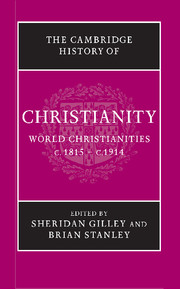Book contents
- Frontmatter
- 1 Introduction
- PART I CHRISTIANITY AND MODERNITY
- 2 The papacy
- 3 Theology and the revolt against the Enlightenment
- 4 The growth of voluntary religion
- 5 Catholic revivalism in worship and devotion
- 6 Women preachers and the new Orders
- 7 Church architecture and religious art
- 8 Musical trends and the western church: a collision of the ‘ancient’ and ‘modern’
- 9 Christianity and literature in English
- 10 Christian social thought
- 11 Christianity and the sciences
- 12 History and the Bible
- 13 Popular religion and irreligion in countryside and town
- PART II THE CHURCHES AND NATIONAL IDENTITIES
- PART III THE EXPANSION OF CHRISTIANITY
- Select General Bibliography
- Chapter Bibliography
- Index
- References
7 - Church architecture and religious art
from PART I - CHRISTIANITY AND MODERNITY
Published online by Cambridge University Press: 28 March 2008
- Frontmatter
- 1 Introduction
- PART I CHRISTIANITY AND MODERNITY
- 2 The papacy
- 3 Theology and the revolt against the Enlightenment
- 4 The growth of voluntary religion
- 5 Catholic revivalism in worship and devotion
- 6 Women preachers and the new Orders
- 7 Church architecture and religious art
- 8 Musical trends and the western church: a collision of the ‘ancient’ and ‘modern’
- 9 Christianity and literature in English
- 10 Christian social thought
- 11 Christianity and the sciences
- 12 History and the Bible
- 13 Popular religion and irreligion in countryside and town
- PART II THE CHURCHES AND NATIONAL IDENTITIES
- PART III THE EXPANSION OF CHRISTIANITY
- Select General Bibliography
- Chapter Bibliography
- Index
- References
Summary
The architecture of two great ecclesiastical monuments of western Christendom can be seen as exemplifying the historicising trend in nineteenth-century art. The first, the Basilica of San Paolo fuori le Mura in Rome, rebuilt from the 1830s onwards, is an expensively confident expression of the last fling of neo-Classicism. The second, Westminster Cathedral in London, completed in 1903 for the newly established Catholic metropolitan diocese, is in the neo-Byzantine style. The architecture of both buildings self-consciously avoids reference to the most commonly employed Christian style of the nineteenth century: the Revived Gothic. Indeed, the two structures are demarcating poles separated by the great mid-century attempt to rival the artistic achievement of the Christian Middle Ages.
The venerable fourth-century Basilica of St Paul was almost entirely destroyed by fire in July 1823. The news of the disaster was kept from the dying Pope Pius VII, who had begun his religious life as a monk in the adjoining monastery, and it was left to his successors, Leo XII, Pius VIII and Gregory XVI, to raise funds for the reconstruction of the church under the Roman architects Pasquale Belli, Pietro Bosio and Giuseppe Camporese. The campaign to rebuild the basilica in a fittingly impressive style was international. Mohammed Ali, the viceroy of Egypt, sent columns of oriental alabaster and Tsar Nicholas I malachite and lapis lazuli for two of its altars. The eastern crossing was reopened for worship in 1840 and the complete church was consecrated by Pope Pius IX in 1854 in the presence of 185 bishops. Despite the grandeur of the eighty granite columns that support its nave, and the richness of its interior, the church has had many detractors.
- Type
- Chapter
- Information
- The Cambridge History of Christianity , pp. 103 - 120Publisher: Cambridge University PressPrint publication year: 2005

